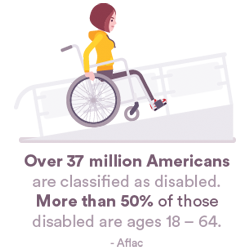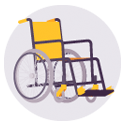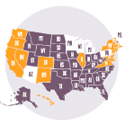 If you get sick or hurt at work, short term disability (STD) insurance helps you cover a portion of your lost income. You can use that money to help pay for your rent or housing payments, food, car payments, utility bills, etc. Generally you receive a weekly payment for a set amount of weeks to help you pay for the things you’d normally buy with a paycheck.
If you get sick or hurt at work, short term disability (STD) insurance helps you cover a portion of your lost income. You can use that money to help pay for your rent or housing payments, food, car payments, utility bills, etc. Generally you receive a weekly payment for a set amount of weeks to help you pay for the things you’d normally buy with a paycheck.
How to qualify for short term disability
What qualifies as a covered disability depends on the definition of a disability, as stated in your plan. A state law may dictate what is covered as well. As the Pregnancy Discrimination Act (PDA) outlines, pregnancy or childbirth is a covered disability.
There are some exclusions that may not be covered by STD insurance. All of these vary by policy, but have to do with the means by which you acquired your illness or injury. For example, you cannot maintain coverage if you are incarcerated during a period of disability. If the following activities resulted in your disability, it could exclude you from STD coverage:
- Intentionally self-inflicted injuries
- Active participation in a riot
- Happened while in the act of committing a crime
- Convicted of a crime or other public offense
- Driving a car while intoxicated (determined by state law)
- War, declared or undeclared, or any act of war
Other terms and conditions on your STD plan may dictate that you must work for your employer for a certain amount of time before you are eligible to receive coverage, and that you must work full-time. These details will vary from plan to plan.
Does short term disability protect your job?
Short term disability insurance does not necessarily guarantee you job protection. You can be terminated while on disability leave. However, there are employment laws to protect you, like the Americans with Disabilities Act (ADA) if you feel your termination was due to discrimination. If you are on FMLA leave, you are entitled to your job when you are able to return to work.
When can you start using short term disability?
You should file a claim as soon as it’s clear (to you or a doctor) that your disability will interfere with your ability to perform job duties and attend work. With STD coverage, you must get past the waiting period, or elimination period, before you are eligible to being receiving payments. An elimination period is generally (but not always) a matter of days that an employee is disabled before benefits are paid out. The specifics on how long you might have to wait are based on the policy and disability you have.
Your employer might have other policies in place that require you to use up your sick days or PTO before being eligible to collect short term disability payments. It’s best to become familiar with all benefit policies and plan terms and conditions.
Who pays for short term disability insurance?
This depends on the plan your employer uses. Your employer will determine many of the characteristics of the STD plan, including the portion of the cost they will cover. Who pays for coverage (your employer or you) is the main difference between short term disability coverage and workers’ compensation coverage. Employers are required by state law to have workers’ compensation insurance when they hire their first employee. It protects employees and employers in the event of an injury on the job.
Is short term disability taxable?
The answer to this depends on how you pay for your disability plan. If you pay with after-tax dollars, you are not on the hook for paying income taxes on the payments you received. If you pay with pre-tax dollars, the amount of payments could be considered part of your income, and you would be liable to pay income taxes on those payments.
What if I can’t get STD coverage?
If you are not eligible for short term disability or are not able to receive coverage for another reason, there may be other options (depending on your circumstances and state laws) that could enable you to receive benefits.
Long term disability benefits

If you are still disabled after your short term disability payments end, you could be eligible to receive long term disability benefits. Long-term disability (LTD) insurance begins after your short-term disability and othersick leave/PTO have been used up. Also has a waiting period (could be weeks or months, but which might include the days you were using STD). How long you can receive LTD benefits varies, could end when you return to work, youare no longer disabled, or you reach social security retirement age.
Social Security Disability (SSDI) benefits

Social Security disability benefits are funded through payroll taxes, and people are considered “insured” because they have worked for a certain number of years and have made contributions to the Social Security trust fund through Social Security taxes. Being eligible for SSDI benefits does not have to do with current employment circumstances, but rather financial need.
How does FMLA work with short term disability benefits?

The Family Medical Leave Act (FMLA) entitles employees up to a certain number of weeks of unpaid leave per year to handle personal or family medical needs. States vary by how many weeks they allow. Employees can receive short or long-term disability benefits while on FMLA leave. FMLA leave provides job protection as long as you don’t take over the allowed number of weeks of FMLA leave per year; you can get your job back or an “equivalent” job. If you can perform essential job functions with reasonable accommodations but your employer hasn’t provided reasonable accommodations, you can’t be fired (whether you are on FMLA leave or not).
What is the difference between state disability benefits and short term disability
coverage?

If you are injured away from work but cannot perform your work duties, you could be eligible to receive state disability benefits which could help cover the loss of income as a result of not being able to work. Thedifference between state disability and STD coverage is liability – with STD coverage, your employer is only liable for the injury or illness that occurred while you were at work.
You can receive some benefits concurrently, like Social Security disability and workers’ comp or state disability benefits. If you do not receive payments from your STD plan or workers’ comp claim, you could be covered by state disability benefits. If you receive state disability payments while you wait for an STD or workers’ comp claim to go through, and then you are granted STD or workers’ comp payments, you will have to repay the state for the disability payments you received.
This process is difficult to figure out. Reach out to your employer to help you understand the terms of your plan, or get legal guidance. XcelHR does provide short term disability insurance coverage to clients. You can learn more about the benefits we offer here.